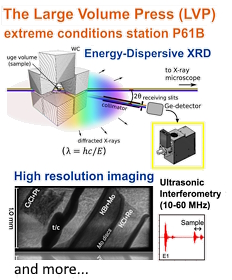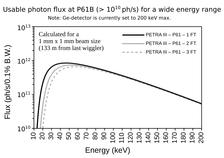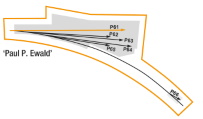Location of beamline P61 and end station P61B in the Paul P. Ewald hall.
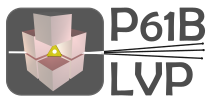
The Large Volume Press (LVP) extreme conditions station uses synchrotron X-ray radiation in a continuous energy range of 30 - 160 keV (although photons with higher energies are produced). The station is designed for the combination of ED-XRD and Radiography Imaging techniques. The structure and properties of samples can be measured in situ using these techniques under extreme conditions of high pressures and temperatures. Various anvil combinations and additional cell assembly set ups are available and being developed.
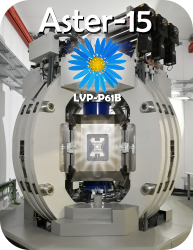 Aster-15, installed at P61B, is the world’s first 6-rams-LVP operated at a synchrotron facility. This type of instrument offers deformation capability, precise control of the anvil positions and high efficiency of pressure generation.
Experiments at extreme conditions of high pressures and temperatures are possible in various modes using a combination of 6 first-stage anvils and 6 or 8 second-stage anvils (6-6 and 6-8 compression geometries, respectively). Using the 6-8 mode with tungsten carbide second stage anvils, pressures up to 30 GPa can be generated at the expense of a smaller anvil gap, up to 10 degrees for diffracted X-rays. Alternatively, the 6-6 mode offers a wider anvil gap, particularly up to 27 degrees in the vertical plane for diffracted X-rays, but the maximum sample pressure is limited to about 15 GPa. Also, controlled deformation of samples is only possible in 6-6 mode using 2 Ge-detectors.
Aster-15, installed at P61B, is the world’s first 6-rams-LVP operated at a synchrotron facility. This type of instrument offers deformation capability, precise control of the anvil positions and high efficiency of pressure generation.
Experiments at extreme conditions of high pressures and temperatures are possible in various modes using a combination of 6 first-stage anvils and 6 or 8 second-stage anvils (6-6 and 6-8 compression geometries, respectively). Using the 6-8 mode with tungsten carbide second stage anvils, pressures up to 30 GPa can be generated at the expense of a smaller anvil gap, up to 10 degrees for diffracted X-rays. Alternatively, the 6-6 mode offers a wider anvil gap, particularly up to 27 degrees in the vertical plane for diffracted X-rays, but the maximum sample pressure is limited to about 15 GPa. Also, controlled deformation of samples is only possible in 6-6 mode using 2 Ge-detectors.
Contact the beamline if you do not have any resources but wish to conduct (in situ) high-PT LVP experiments on scientifically interesting materials. Other information about the beamline can be found in the menus on the left. If you have any questions, please do not hesitate to contact the beamline manager, Dr. Robert Farla.
Application of high load and temperature may cause anvils to break, resulting in an implosion, a shock to the press stages and a blow out of materials. P61B will continue to update its policy to minimise this risk in order to avoid damage to the detector system, diamond exit window, anvils in the LVP and LVP stages. Failure to follow these rules can end your beam time.
- During heating or deformation, someone must be present in the CH. Unattended compression and decompression is permitted.
- UHP experiments (> 30 GPa) MUST use the diamond exit window shield as shown in the photograph.
- The target sample pressure described in the proposal should NOT be exceeded unless a strong scientific arguement is given. Furthermore, if the target sample pressure cannot be reached because the assembly does not generate pressure efficiently (e.g. < 1 GPa over 100 bar, check P-load curve), then further increase in press load should be avoided.
- Increasing the press load to the maximum capacity of the LVP to obtain a slightly higher sample pressure 'for fun' will end your beam time.
- Always enter a complete pressure profile for the master ram with an up-ramp, a dwell, and a down-ramp, to ensure the PC/PLC will always control the oil pressure in the LVP.
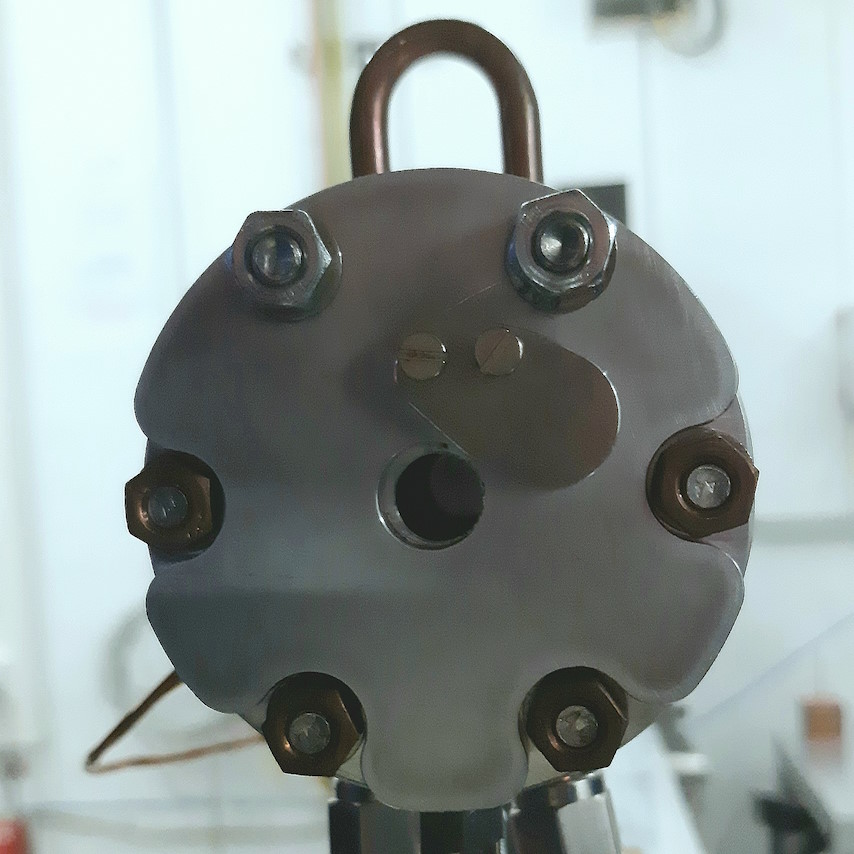

Announcements
P61B continues normal operations. The guest house is usually fully booked out. Please register as early as possible!
Call for proposals:
Regular proposals: CLOSED (deadline: tba)
Long Term Proposals: CLOSED (deadline: tba)
Offline LVP proposals: OPEN (see below)
Meetings:
P61B @ SRI, Hamburg: UPCOMING (26-30 Aug 2024)

Apply for offline LVP experiments
↦ Submit a project proposal for offline experiments in the LVP. Applications for up to 5 days for one or multiple visits during the available periods are possible.
Available dates in 2024:
- 07 - 11 October
- 14 - 18 October
- 28 Oct - 01 Nov
- 09 - 13 December
Key limitations:
1. Generally no user support on weekends.
2. Availability of dates is subject to school holidays and beamline maintenance during shutdown periods

Apply for benchtop XRD
↦ Apply for the use of the beamline benchtop X-ray diffractometer. Applications can be submitted any time.
The GNR theta-theta XRD
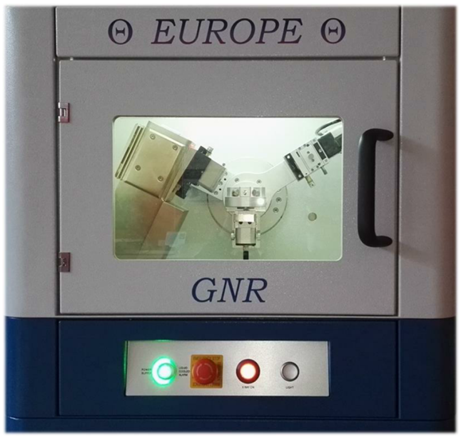

Visiting guidelines
↦ Read the following information here, before visiting.
Please decide whether you prefer Collaborative or Independent beam/experiment time.

The BMBF funded the project 05K16WC2 Aster-15 LVP, titled "Erweiterung der Druckbereiche der In-Situ-Röntgenbeobachtung mit der Großvolumen-Hochdruckapparatur an der PETRA-III-Extension des Deutschen Elektronen-Synchrotrons DESY" from University Bayreuth (T. Katsura).





